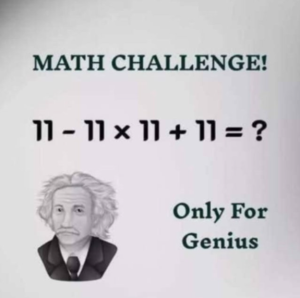Try Solving It Without a Calculator — Use Your Mind: A Journey Into Mental Math and the Power of Focus
In a world dominated by smartphones, smartwatches, and instant search engines, the simple act of solving a math problem using only your brain has become almost revolutionary. Gone are the days when people memorized multiplication tables, performed long division by hand, or calculated tips without pulling out a phone. But what if we paused, just for a moment, and challenged ourselves to solve something — anything — using only the power of our own minds?
“Try solving it without a calculator. Use your mind.” It sounds almost old-fashioned, like something your teacher or grandfather might say. Yet, in those words lies something deeper: a call to reclaim focus, sharpen mental clarity, and trust your own intellect.
The Power of Mental Math
Mental math isn’t just about crunching numbers. It’s about focus. Confidence. Strategy. It trains the brain to stay sharp, think critically, and recognize patterns. Studies have shown that individuals who regularly use mental math are quicker problem-solvers, more agile thinkers, and even more patient decision-makers.
When you’re asked to figure out “What’s 17 times 23?” without a calculator, your first instinct might be panic. But pause. Think.
Break it down:
-
17 × 23
-
= 17 × (20 + 3)
-
= (17 × 20) + (17 × 3)
-
= 340 + 51
-
= 391
No calculator. Just structure and logic.
That’s the beauty of it — training your brain to look at problems not as hurdles, but as puzzles. And puzzles are fun when you believe you can solve them.
The Struggle is the Magic
Solving problems mentally builds more than math skills. It strengthens memory, teaches perseverance, and improves attention span. In fact, every time you resist the urge to “just Google it” or ask Siri, you’re building mental muscle. The struggle — the moment of silence, confusion, retrying — that’s where the magic is. That’s where your brain grows.
Think about it: the first time you try to subtract 347 from 1,000 in your head, it’s a challenge. But once you master it with a simple trick — subtract from 999 then add 1 — you never forget.
-
999 – 347 = 652
-
652 + 1 = 653
Now you have a life skill — not just an answer.
Why We Stopped Thinking
Technology is amazing. It gives us answers in seconds. But it also has made us a little… lazy. Why memorize multiplication tables when you can type “76 x 88” into Google and get an instant answer? Why remember how to calculate percentages when an app can do it for you in half a second?
But here’s the cost: dependence. Over time, we lose the confidence to think for ourselves. We stop trying. Our mental math “muscle” weakens, and slowly, we become afraid of numbers, even simple ones.
That’s why the challenge of solving problems in your head matters now more than ever. It’s a rebellion — a small act of defiance in a world that tries to make everything automatic.
A Test: Try These Without a Calculator
Before reading the answers, try solving these in your mind:
-
What’s 25% of 240?
-
Multiply 12 by 15.
-
What’s 300 divided by 5?
-
If you buy 3 items for $7.25 each, how much is the total?
-
What’s the square of 16?
Now let’s work through them:
-
25% of 240 is 1/4 of 240 = 60
-
12 × 15 → (10×15 + 2×15) = 150 + 30 = 180
-
300 ÷ 5 → Think: 30 ÷ 5 = 6, then add the zero = 60
-
3 × 7.25 → 3 × 7 = 21, 3 × 0.25 = 0.75 → Total = 21.75
-
16 × 16 = 256 (memorize squares at least up to 20) → 256
See? Just a few seconds of concentration and structure — no calculator needed.
Beyond Numbers: Mental Discipline
The idea of “solving it without a calculator” isn’t only about numbers. It’s symbolic of a deeper principle: engaging your brain before outsourcing your thinking. That applies to everything — from navigating directions to making decisions, even to solving emotional challenges.
When you practice mental math or force yourself to pause and think, you’re saying, “I trust myself. I can figure this out.” That self-trust is invaluable.
Imagine you’re in a grocery store and trying to figure out which deal is better:
-
2 bottles of olive oil for $6.98
-
Or 1 bottle for $3.79
Do you wait in line to ask the cashier? Open your calculator app? Or do you do the math in your head?
-
2 × $3.79 = $7.58
-
So, 2 for $6.98 is clearly the better deal.
That’s power. Independence. Efficiency.
Teaching the Next Generation
This mindset matters even more for the younger generation. Children growing up with devices in their hands from age 3 may never learn how to calculate change, budget mentally, or make quick estimates.
Encouraging kids to solve simple problems without devices nurtures brain development and builds confidence. Even just asking your child, “How many quarters are in $5?” can lead to an aha moment.
(Answer: $5 = 500 cents → 500 ÷ 25 = 20 quarters)
Bringing It Back
So how do we bring mental math and deep thinking back into our lives?
-
Start small. Try to do simple calculations in your head daily — tips, totals, time conversions.
-
Challenge yourself. Give yourself mental puzzles during quiet moments: in the shower, waiting in line, or walking.
-
Practice regularly. Like any muscle, your brain needs regular use to stay sharp.
-
Play math games. Sudoku, mental math apps (ironically), logic puzzles — all help.
-
Teach others. Share tricks and shortcuts with family and friends. Make it fun.
The Takeaway
“Try solving it without a calculator — use your mind.”
This simple idea is about more than math. It’s about slowing down, thinking critically, embracing a challenge, and becoming more confident in your own intelligence. It’s about fighting back against mental laziness in a world that rewards convenience over effort.
So next time someone throws a number your way, don’t reach for your phone. Take a breath, close your eyes, and give your brain a moment to shine.
